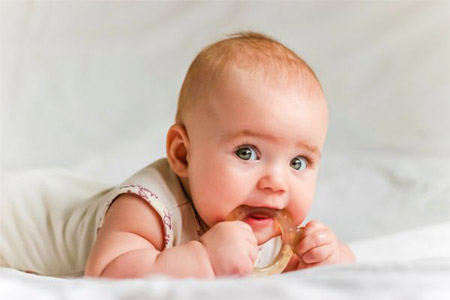Teething Rings
Help! Is baby fussy because he is teething? Know that there are numerous teething rings on the market.
This must-have helps relieve inflammation and pressure caused by painful gums, especially at the eruption of lateral incisors and first molars.
Different types of rings
When the time comes, there exist many different kinds of teething rings to choose from. There is one for every step of the teething process.

Teething Nipples
For babies 3 to 6 months old who cannot yet hold a teething ring. Teething nipples offer your infant much needed gum relief.
Textured Surface Rings
These come in various shapes. Some resemble animals, insects, fruit or any other object that may appeal to babies.
Cooled Rings
Cooled rings (made of gel or water) help soothe baby’s gums and make tooth eruption less painful.
Activity Rings
This model of ring stimulates baby’s different senses as well as his dexterity.
Baby Massages
As parents, we would do anything to comfort and soothe baby during teething. Here are a few massages that will help distract the infant during this difficult time.
Localized massages

1
Make yourself comfortable in a calm, quiet place. With your thumbs gently rub small circles on baby’s skin in the area around his upper lip. Exert moderate pressure and adjust it according to baby’s reactions.

2
Next, move your hands towards the middle of his cheeks and with your index fingers, trace out larger circles.

3
Do the same thing on the lower jaw: make small circular movements with your thumbs.
While massaging, describe each movement to baby to reassure him: calming baby can also be accomplished through words.
Massages associated with reflexology

1
Make small circular movements at the base of each of baby’s nails. Make sure to work carefully at the base of the nail, not directly on the nail.

2
Adjust the pressure and if your fingers don’t slide along easily, rub them with a drop of softening oil.

3
Repeat this massage on all nails of the hand as long as baby seems irritated by teething.
In the hand, the area that corresponds to the gums is located at the base of the nails, and massaging it regularly helps to relieve pain associated with teething.
Once upon a time…milk teeth!
Have you ever asked yourself why baby’s primary teeth are called milk teeth?
This expression stems from the fact that the primary teeth erupt while the baby is feeding mostly on milk and where the teeth are as white as milk.
Teething Calendar
The order in which baby teeth appear is not an accident. Each tooth comes through in its own time.
Print the calendar and write the eruption date of each of your baby’s teeth.
Dental Care
Your baby’s primary teeth are crucial. They define the shape of your baby’s face, position the permanent teeth and are essential in helping your child eat and speak.
Good oral hygiene begins with the primary teeth. Read what follows to learn about how to care for your infant’s mouth.

0 to 12 months old
- Once the first teeth start to come out, wipe your baby’s gums with a clean, damp facecloth twice a day.
- Brush the infant’s primary teeth once a day with a special baby toothbrush.
- To do this, lay your baby down on a flat surface or place his head on your knees.
- From the age of 6 months, give your infant a beaker cup.
- If your child still uses a bottle, give him water to drink rather than milk or juice.
1 to 2 years old
- Visit the dentist for the first time when your child is 12 months old.
- Make sure to brush your child’s teeth daily (with a non-fluoride toothpaste).
- Check for signs of cavities once a month.
- When your infant is about 12 or 15 months old, he can drink out of regular cups.
- Reduce the use of a pacifier during naps and bedtime.
3 to 4 years old
- Teach your child the “2 by 2” game which consists of brushing teeth for two minutes twice a day.
- Encourage your child to brush his teeth on his own. Finish the task for him by ensuring that all surfaces have been cleaned.
- Set an example by brushing your own teeth beside him.
- Introduce fluoride toothpaste by placing a small dollop on your child’s toothbrush. Teach your child to spit out rather than swallow the toothpaste.
- Supervise your child when brushing.
From the beginning to the end of teething
- Wash your hands before and after brushing.
- Rinse toothbrushes after use.
- Replace toothbrushes every few months.
- Between meals, satisfy your child’s thirst with water.
- Take your child regularly to see the dentist.
Tips for Parents
Being a parent does not come with instructions. We tend to forget about ourselves 24 hours a day as we turn into superwoman or superman.
When baby cries, days are long and nights are all too short.
Here are some helpful tips for parents to recharge their batteries:

- Turn off your mobile phone and keep away from your computer
- Go for a walk in the park and look at nature
- Sit facing the sun and close your eyes
- Take a hot bath in restful surroundings with candles and soft music
- Sew, knit, embroider…
- Draw or undertake a DIY project
- Invent a new recipe
- Tend to your garden or for your indoor plants
- Pet an animal
- Sing out loud (even if out of tune) in the shower, at home or in a choir
- Play a musical instrument
- Dance
- Visit a museum or attend an exhibition
- Take up a sport
- Write a letter of thanks to someone (altruistic acts reduce stress hormones)
Quiz
Think you know everything about teething? Test your knowledge here!

